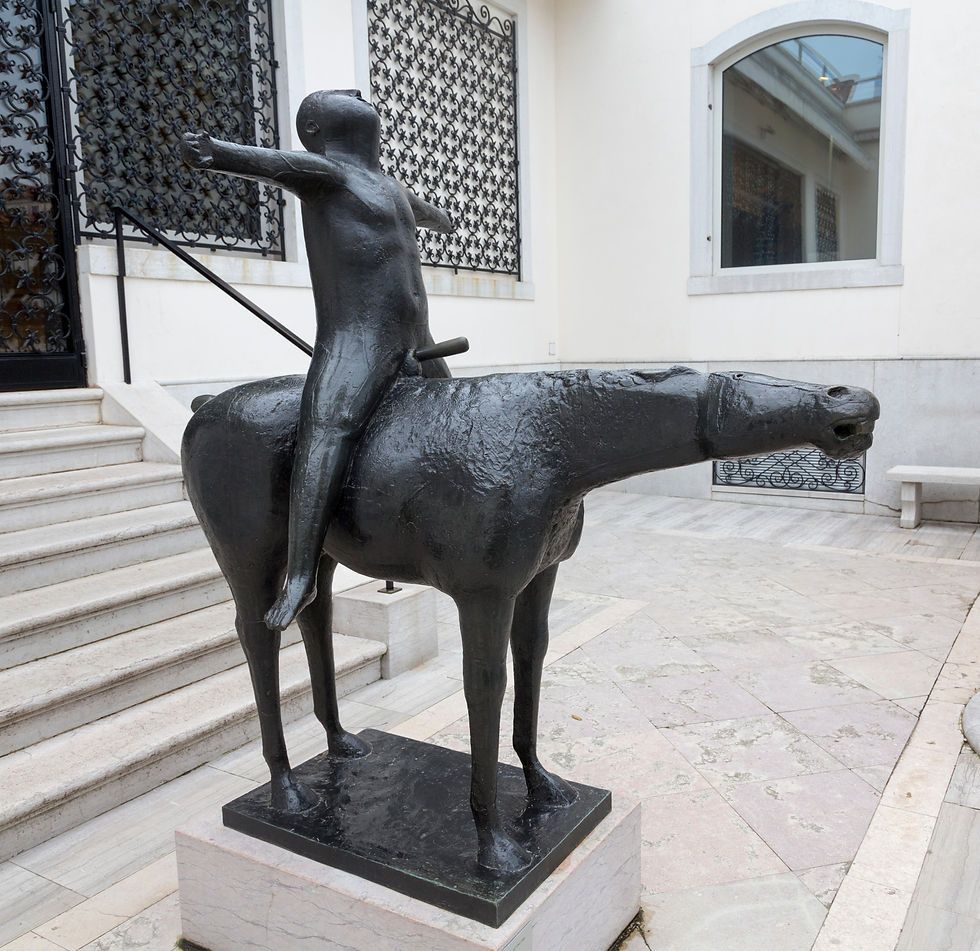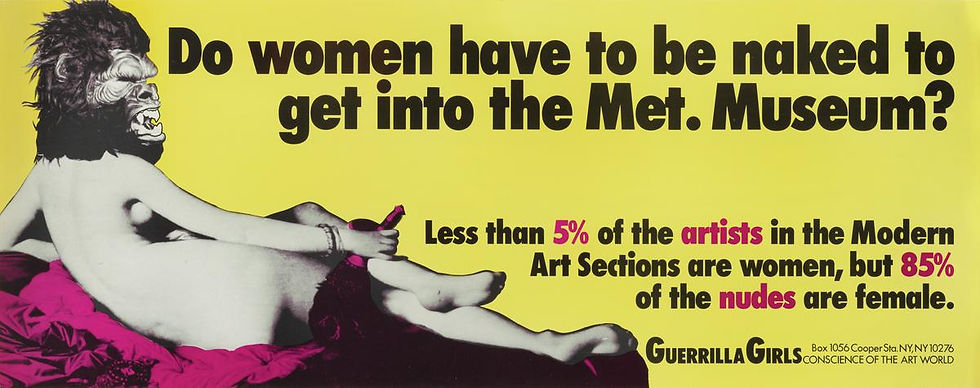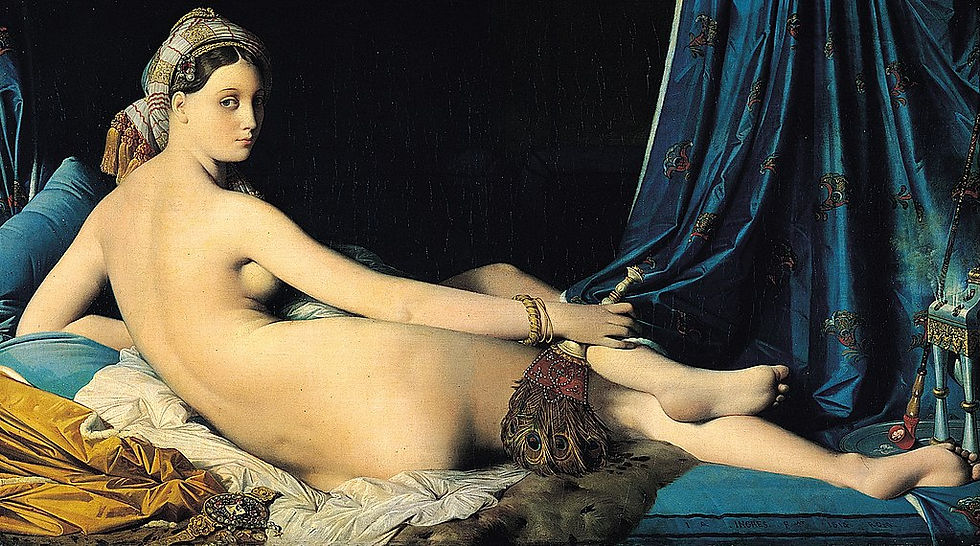One thing I love (and there are many) about the English language is that there are so many ways to describe being naked - you can be starkers, stripped, bare, undressed, in the buff, in the altogether or - my favourite - in your birthday suit. But, I once overheard the leader of a French school group tell her tittering teenage charges in a gallery that in art there is only one word for it: nude. Unsurprisingly, this linguistic gem of knowledge didn’t really make the naked paintings any less amusing to those kids, but really - who can blame them? I’m not convinced it’s actually the case.
Most discussions in the great ‘naked vs. nude’ debate feature art historian Kenneth Clark’s work, The Nude: A Study in Ideal Form. According to Clark, "the word [naked] implies some of the embarrassment most of us feel in that condition”, whereas 'nude' “carries […] no uncomfortable overtone.” Basically, while being naked is often funny, awkward or generally not ok, there’s nothing inappropriate about nudity, because it’s an idealised, aesthetic celebration of the human body. According to Clark, it is a distinction introduced by critics in the eighteenth century. He goes deeper, but on the whole, you can see how this becomes an easy rule of thumb: Art = Nude. Not Art = Naked. And, the 18th century implication follows, if you’re sophisticated and refined - if you ‘get’ art - you know the difference, and so you definitely don’t giggle at willies in galleries.

Luncheon on the Grass, Édouard Manet, 1869
Now, Clark was unpacking all of this in 1959 - so why rehash old ground in 2024? To be honest, this is kind of CULTUR.ART’s Roman Empire; we think about it at least once a week. We post a lot of art on TikTok and Instagram. And these platforms’ automatic content scanning algorithms detect and remove content that features nudity, violence, and other subjects which may be inappropriate for younger users. These content policies - like Clark’s eighteenth-century critics - make exceptions for nudity in the context of cultural practices and art. (Quoted here, Instagram, in an exquisite example of understatement: that’s “ok”.) But while long-suffering school trip chaperones and art critics know the difference and apply it to their viewing, surprisingly, pattern recognition algorithms struggle to recognise what is and isn’t art when nipples are involved.
This leads to practical and ideological problems for galleries, artists, art fans, and, well, us. We all want to share and talk about art without having our accounts shut down. Or worse, shadowbanned. Campaigns like "Free the Nipple'' highlight this ongoing resistance against digital censorship - whether purposeful or incidental. “Don’t Delete Art” has taken this one step further, curating a gallery of censored art online. However, the conflict over what is acceptable nudity and what is censorship material hasn’t actually magically resurfaced because social media was invented. This is just the latest iteration. And so thinking about what’s been covered up, and what’s been left on view throughout history makes it hurt a little less when we yet again enter an appeals process with the gods of Instagram.

David, Michelangelo, c.1501-1504
For example, Western Art History’s most famous nude dude, Michaelangelo’s David, wasn’t always the naked icon we know and love today. In 1504, the statue was given a gilt loin garland to safeguard the public’s moral virtue. This habit of covering artistic naughty bits was formalised in a 1563 edict by the Catholic Church and became known as the Fig Leaf Campaign. The practice spread beyond Italy and is the longest-running censorship campaign in Art History. Even David - or the cast copy of him that lives in the V&A, London - received his very own detachable fig leaf in 1857, apparently at the behest of Queen Victoria. These days, I'm pleased to say, he’s fully naked again, his fig leaf displayed separately in a glass case. Nevertheless, the legacy of the fig leaf lives on, applied to Damien Hirst’s St Bartholomew, Exquisite Pain sculpture for display in China and Qatar in 2014.

The Angel of the City, Marino Marini, 1949
The prolonged use of “nature’s jockstrap” beyond the eighteenth century (thank you, Stephen Smith, for this term that I will never unhear) clearly shows that the naked/nude distinction wasn’t this great watershed moment. We didn’t all collectively stop being small-minded prudes, and became enlightened appraisers of the human form. And it’s not like we all suddenly stopped finding naked statues just a little bit funny sometimes; in The Peggy Guggenheim Collection, Venice, Marino Marni’s 1936 Angel of the City sculpture overlooks the Grand Canal. It is famous for its (very large, very erect) detachable phallus. Precisely why Guggenheim would unscrew the sculpture’s rather prominent member range from sparing the blushes of passing nuns to simply (and, I think, hilariously) indicating to potential visitors that she wasn’t at home. My point is, that no one is accusing Peggy of not being one of Art’s great sophisticates, but clearly, she knew how to have a laugh about it too.

Do Women Have To Be Naked To Get Into the Met. Museum? The Guerilla Girls, 1989
And it isn’t just the male anatomy that can be tongue-in-cheek. The Guerilla Girls’ 1989 lithograph, Do Women Have To Be Naked To Get Into the Met. Museum? parodies the painting Grande Odalisque (1814). The title, the poster format and the pose of the figure in a gorilla mask, steamroll the highbrow/lowbrow divide between the nude and the naked. What you call it doesn’t matter so much, the poster implies, if the outcome is still thinly veiled voyeurism, with no acknowledgement of women’s substantial contributions to art.

La Grande Odalisque, Jean Auguste Dominique Ingres, 1814
In 2021, adult entertainment website, Pornhub, sparked controversy with their ‘Classic Nudes’ project. It included racy gallery maps, salacious oral histories of famous artworks, and saucy recreations of classic paintings by pornstars. The point is clear - compositionally, these reenactments don’t differ much from the artworks, and yet you’d only call one set of images pornographic. This clash of traditionally highbrow and lowbrow - but equally naked - media blurs the lines between art and pornography, the orthodox and the obscene, nudity and nakedness. The project introduced new audiences to old institutions and brought a fresh perspective on the nature of artistic expression. However, it also invoked lawsuits from the Uffizi Gallery and the Louvre, and attracted criticism for re-perpetrating the Guerilla Girls’ original problem - an emphasis on the white male gaze.

Adult entertainer Cicciolina recreates Botticelli’s The Birth of Venus, 1485–86, with Pornhub.
Today, as digital platforms like TikTok and Instagram grapple with content moderation, statues have body parts concealed and revealed, and porn empires partner with Renaissance painters, perhaps what’s becoming clear is that more interesting than the distinctions - the terminology - is the friction they generate. What Michaelangelo, Marni, The Guerilla Girls, Mark Zuckerberg and Pornhub’s marketing team (and can you imagine that dinner party combo?) collectively teach us is that what’s important is the clashes. Use whatever words you want for art because for all that it’s culturally enriching, that doesn’t mean it can’t be shocking, titillating or amusing too.
Ultimately, the only thing we know for sure is that, whether in reverence or humour, whether through presence or absence, naked figures remain a vital part of our artistic landscape. And that landscape spans Venetian Galleries, Instagram feeds, and can even be found somewhere in the bowels of Pornhub. At least, that’s what I’ll be telling HR when they call me in to discuss my internet search history after researching this article. And if someone could mention it to Zuckerberg too, that would be great.
What do you think? Is it rude to be nude?
Yes.
Absolutely not!
Interested in reading more articles? Check out all our other pieces, and subscribe to our Substack for a weekly blog!
Comentarios